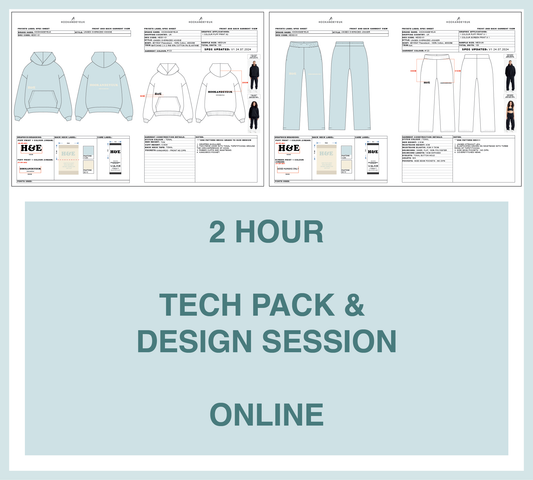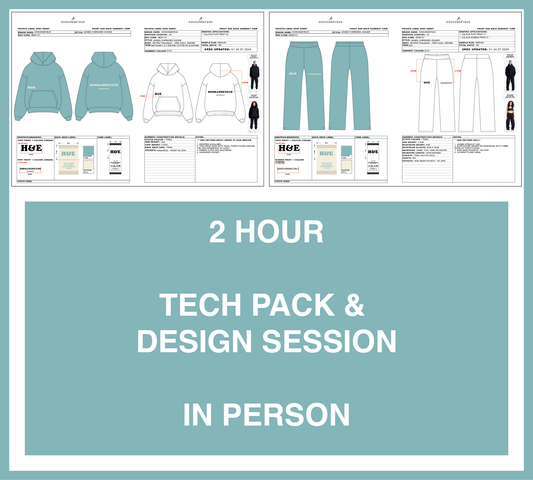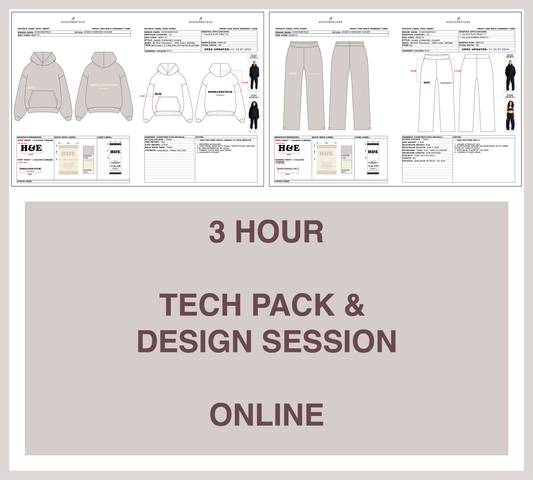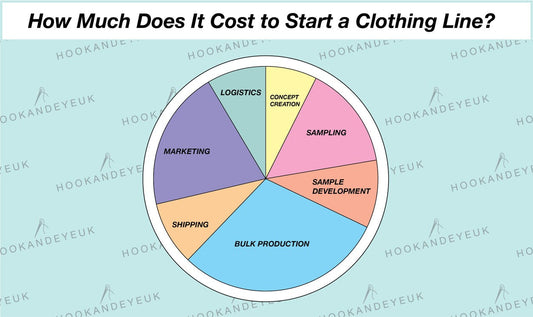Getting your size guides right is crucial for e-commerce clothing brands. By giving your customers clear measurements in the form of a sizing chart, they can quickly understand which size will fit them best, boosting your chances of making sales and reducing your number of returns and exchanges.
But not all size charts are effective, and some are just plain confusing. So, how do you create a good size chart? We're going to give you all the info you need below...
Have you ever found yourself staring helplessly at an online store’s size guide, trying to decipher from the measurements on the screen which size you should order? I know I have! Whilst typing this, I’m browsing through a number of websites, checking out how all the big brands present their sizing charts, and whilst some are really helpful and clear, a lot of them, quite frankly, leave me baffled about which size would fit me best as a consumer. So, let's make sure your size guides are doing their job properly!
First off, what is a clothing size chart chart for?
A clothing size chart (a.ka. measurement chart, size guide or sizing guide) used in e-commerce stores is designed to help your site visitors understand what size to order for themselves. As they can't physically try on the garments, it's a handy way of seeing which size they should buy.
Here's an example below from Aries:

Example of a size chart, from Aries, E-commerce Website, 4 June 2024
Why are sizing charts so important?
Within the clothing industry, there is no standardised sizing guideline, meaning one brand's size medium, for example, could be totally different to another brand's size medium. We’ve all been there – I’m a size 8 in some shops but a 12 in others!
This is why measurement charts, if used well, can be crucial for conveying to your customer what your brand's sizing is and how a garment will fit them.
Given that it's an online purchase, providing a clear method of understanding what size they are ordering can help boost your sales (as people can easily know which size is right for them), and reduce the amount of returns and exchanges you have to deal with.
Maximising sales and minimising your returns is absolutely essential for a successful e-commerce clothing brand.
Why size charts can be confusing
So, as I mentioned, from looking at lots of different brands' size guides and measurement charts, some are great, some are OK and some are just plain confusing.
Often I found myself faced with a chart of numbers, which indicate, various different measurements. Typically for a top or t-shirt, these would be chest, waist and hip circumferences. I’m familiar with these measurements and know how to measure myself correctly. But, what really isn't clear, in some cases, is what are the measurements provided by the retailer actually referring to? Are they the measurements of the actual GARMENT I will be buying? Or are they BODY measurements that then match to an appropriate clothing size?
There’s a distinct difference between the two and if this isn’t made clear, it can be super confusing for your website's visitors, and confused visitors don't tend to turn into customers. In fact, not having clear, easy-to-understand size guides can really knock your rate of sale, and even worse, give you the headache of managing more returns than you need to.
Below we’re going to explain the differences between body measurements and garment measurements, and discuss the best way to present your measurement chart!
Size Guides: The difference between body measurements and garment measurements
There are a number of ways in which brands help you figure out sizing on their online stores. Some offer diagrams of where to measure your body, some give the measurements of their clothes, and some even ask you to input data such as your height, weight and body shape, then tell you what size you should order.

The downside of measuring methods that ask you to measure your body, then match you up to a clothing size, is that you don’t know exactly HOW that garment will fit you. The brand has made an assumption that if your body is this size, you will fit this size garment – the trouble is that every customer likes to wear their items at a certain fit. Some customers will love their clothes to be figure-hugging, whereas others prefer a looser fit.
Personally I find body measurement charts frustrating because I rarely match up to one size! My bust, waist and hip measurements will quite often each fall into a different size bracket! If you haven’t got an ‘average body shape’, you might be stuck across a couple of different sizes and unsure about which would fit you best.
This leads us on to what is, in our opinion, the best and easiest way to provide garment sizing information for e-commerce clothing brands, and that’s by using GARMENT measurement charts.

Clothing Measurement Chart from Fear Of God (Essentials), Ecom Website, 4 June. 2024
Garment measurement charts list the measurements of the actual clothing item, and lots of big brands do this. See the example above from Fear Of God Essentials.
By providing these numbers, it is clear what the exact size of the clothing item your customers will receive is. A really helpful way for a customer to visualise this is by comparing these measurements with a similar clothing item they already have at home, and then work out the size they want to go for.
Essential Garment Measurements for Your Clothing Size Chart
In clothing size charts, the key fit points listed are often; chest width, body length and sleeve length for tops, and waist width, inside leg length and leg width for trousers.
Go one step further to help your customers by showing them exactly where to measure from so there is no misunderstanding, the below example from Represent uses a clear visual showing you how to take each measurement.

Represent, Ecom Website, 4 June. 2024, https://uk.representclo.com/products/represent-owners-club-hoodie-ash-grey
Top tip: garment measurements are always taken from a flat garment, i.e laid on a flat surface, never from a garment on a body.
How Fabric & Fit Impact Your Size Chart & Garment Measurements
It’s important to convey to your customer how a clothing item is intended to fit them, and also how the fabric contributes to or affects this. The fabric used for a garment plays a huge part in how it fits and the measurements of that garment.

If we take a look at three basic fits for example; oversized, fitted, and skintight. The measurements of oversized garments will be much bigger than your body measurements, fitted garments will be just a little bigger than your body measurements, and skintight garments (stretch items), will be smaller than your body measurements.
Take a look at the below example. Both tops are a size 8, and both fit me perfectly, but in very different ways. The top item is a boxy cropped tee made from 100% cotton, intended to be worn as an oversized piece, so its measurements are significantly bigger than my body. The bottom item is a stretchy vest made from polyamide and elastane. It’s intended to be tight and figure hugging, therefore the measurements are smaller than my body measurements and the stretchiness of the fabric allows it to stretch to fit to my body perfectly.

By outlining the intended fit for your product, and adding in as much information as possible for your customer, combined with a garment measurement chart, you will minimise any uncertainty about sizing and instil your customer with confidence that your clothing will fit them how they imagine!
Why Including Model Measurements Helps Customers Choose the Right Size
It’s a great idea to add information about your models next to your photos. Listing your models' body measurements or size, height and what size garment they are wearing helps add a 3D visual element to back up your sizing information. The example below from Stussy is super clear, easy to understand quickly and provides all the necessary information.

Stussy, E-commerce Website, 4 June. 2024,
How to Generate an Accurate Garment Measurement Chart from Your Manufacturer?
You might be wondering how to get the measurements you need to create your own size chart. Your clothing manufacturer should provide you with this, at Hook and Eye UK we provide our customers with a garment measurement chart after committing to bulk production. That way you can add garment measurements to your online size charts.
In Conclusion: Effective Size Charts for e-commerce clothing brands
Good clothing measurement charts are vitally important for e-commerce clothing brands, helping to improve customer satisfaction by building confidence in your product and reducing the likelihood of returns due to items not fitting as imagined.
Providing measurements of a garment itself rather than trying to match up body sizes to garment sizes, will be easier for you as a retailer and easier for a customer to compare with items in their own wardrobe.
A key thing to remember is to make it clear to your customer what the information you are providing relates to - state that the measurements were taken from a garment laid flat, and demonstrate exactly what points the numbers were taken from, so that they can compare accurately with an item of clothing that they own.
List all the information you can to back up your product imagery, such as how a garment fits, what the fabric is and what your models measurements are. If you'd like more top tips on how to write a great e-commerce product listing, see our blogpost on Copywriting for Fashion Brands here.
Love, Bethany H&E xx
P.s We're here for you if you have questions drop us a WhatsApp on +447939591255

About the Author: Bethany is an experienced fashion designer at Hook and Eye UK, with a First-Class BA (Hons) degree in Fashion from the University of Northampton. She is the recipient of both the Fashanne East Midlands Design Award and the CORDURA Durable Design Award, recognising excellence in design and durability. Bethany began her career as a Design Assistant within the uniform industry, contributing to ranges for major brands including HSBC, EasyJet and Costa Coffee. She later worked as an Accessories Designer, creating licensed products for leading UK retailers such as Next, M&S and New Look. She joined Hook and Eye UK in November 2023.








